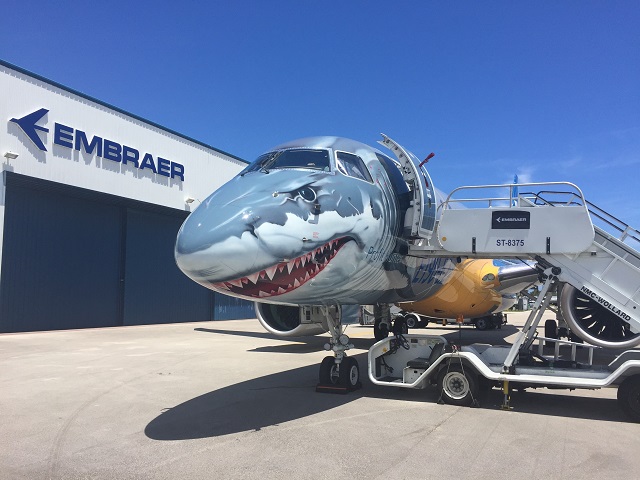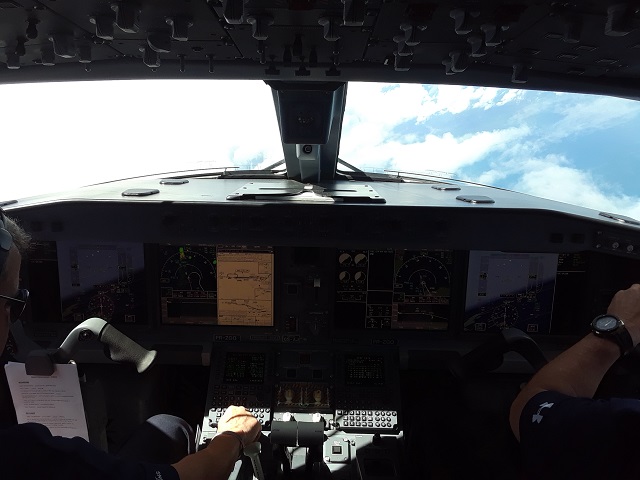Embraer has highlighted Alaska Airlines, Spirit Airlines and United Airlines as US carriers that would most benefit from operating the Brazilian company's new-generation E-Jet E2 family.
A top Embraer executive described those airlines as "market opportunities" on 22 August, shining light on Embraer's marketing strategy following a recent sales loss to JetBlue Airways and a still-uncertain tie-up with Boeing.
Embraer also faces invigorated competition from the now-Airbus-backed A220, formerly known as the Bombardier CSeries.
"The E2 is different from anything else on the market," Embraer Commercial Aircraft vice-president of marketing Rodrigo Silva e Souza tells reporters at the company's Fort Lauderdale-Hollywood International airport facility. "It's a completely new aircraft."
He cites the E2's newly designed wing, fly-by-wire technology, efficient Pratt & Whitney geared turbofans, two-by-two seating and veteran support network as prime attributes.
In laying out specific reasons why Alaska, Spirit and United would be smart to acquire E2s, Souza stresses that the E2 line's low trip cost can enable Alaska, Spirit and United to successfully expand into smaller, yet undeveloped markets. He also says E2s are ideal replacements for Boeing 737-700s and Airbus A319s.
Embraer's E190-E2 demo aircraft, decked in the company's "Profit Hunter shark livery", at Fort Lauderdale on 22 August.

FlightGlobal
The E2 line, which includes the recently certified E190-E2 and the in-development E175-E2 and E195-E2, collectively occupies the roughly 76- to 146-seat market.
Alaska has not yet expressed interest in E2s and remains focused on taking delivery of its outstanding E175 orders, it says.
Spirit has not responded to requests to comment about potential E2 plans. United declines to comment.
United has already expressed interest in purchasing small narrowbodies such as E2s, A220s, 737 Max 7s or A319neos. Likewise, all-Airbus operator Spirit has indicated talks with Airbus, Boeing and Embraer about an aircraft order that could come in six months, Spirit chief executive Robert Fornaro recently told reporters.
Embraer's Souza notes that United has recently been adding more flights to its hubs, particularly flights from smaller cities – an effort to carry more connecting, higher-yielding passengers.
"The E2 could have an important role for United," Souza says. "The size of the aircraft… [is] perfect to develop those new routes, and to have a higher profitability."
He presents data showing that 53% of United's passengers connect – a rate several points less than American Airlines' and Delta Air Lines' connection rates.
"It needs to improve connectivity," Souza says of United.
Likewise, E2s would enable Spirit to launch service on "long and thin" routes currently bypassed by a route network that primarily connects major markets, Souza says.
Spirit currently operates 31 A319s, the smallest aircraft in its fleet, according to FlightGlobal's Fleets Analyzer database.
"The A319 is certainly not the most efficient aircraft to do that," says Souza. "If you want to go to smaller markets, what you really want in your fleet is a low trip cost."
The same goes for Alaska Airlines, which operates 10 A319s and in recent years has expanded significantly to mid-America, mid-sized markets, such as Milwaukee, Omaha and St Louis. Alaska has done so largely using current-generation E175s.
"We see opportunities… for replacing A319s, and to be the small narrowbody in their fleet," Souza says of Alaska.
The cockpit of Embraer's demo E190-E2 while in flight over Florida Bay on 22 August

FlightGlobal
CLOSING SALES
Recent months have seen upheaval in the small-narrowbody aircraft market, with Airbus acquiring a majority ownership of the CSeries, and Boeing and Embraer announcing their intention to form a commercial aircraft joint venture.
The Airbus-CSeries deal, which closed in July, did seem to invigorate interest in the now-branded A220.
That same month JetBlue Airways chose not to acquire E2s, instead ordering 60 A220-300s. Those aircraft will replace JetBlue's 60 existing E190s, which it plans to divest by 2025.
Then during the Farnborough air show Airbus also announced that David Neeleman, who founded JetBlue, tentatively agreed to buy 60 A220-300s as part of a plan to start a new US carrier.
Airbus' current A220 backlog stands at about 360 aircraft, it says.
Embraer's deal with Boeing, however, remains unsettled, with the companies having said the agreement will be finalised by the end of 2019.
Embraer executives decline to provide updated information about the potential tie-up.
Meanwhile, Embraer's E2 order book has remained relatively flat. The company held unfilled orders for 227 E2s at the end of June, though in July Wataniya Airways ordered 10 E195-E2s
Those figures remain only a fraction of the thousands of E2-sized aircraft that Embraer predicts airlines will need in the next 20 years.
But Souza insists an E2 order wave will soon crest, predicting interest will surge as more aircraft enter service.
Embraer delivered the first variant, the E190-E2, to Norwegian carrier Wideroe earlier this year. It expects to certify the first E195-E2 in 2019 and the final variant, the E175-E2, in 2021.
"Over the next 12 months we should see an increase in sales activity," Souza says. "Next year I expect more activity" from North American carriers, he adds.
Source: Cirium Dashboard



















